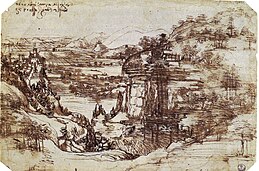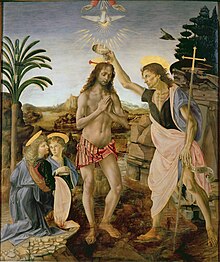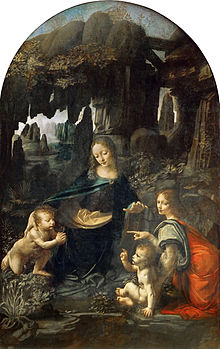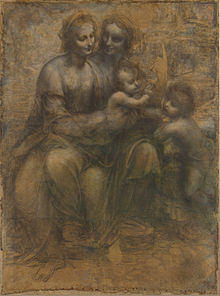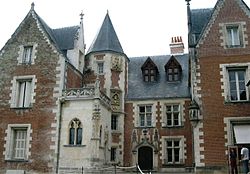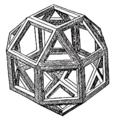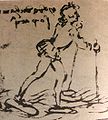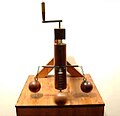The great artist, mathematician, writer and inventor Leonardo Da Vinci was born in Italy. From the very beginning of his life he was so special and talented that these qualities stopped him from receiving a good education. However, as most other great people, Da Vinci still had a desire for knowledge and great ambition.
Leonardo Da Vinci started working as an apprentice of the painter Andrea Del Verrochio in Florence when he was only 15. With the help of his teacher he became an artist, having developed his skills and even intimidated his mentor. However, Da Vinci wanted to broaden his knowledge in other spheres as well.
In 1482 he started realizing himself as an inventor. In order to broaden his scope of work, Da Vinci moved to Milan where he worked for Duke Ludovico Sforza as a military engineer. At that time many of his famous military inventions came out.
The period of living and working in Milan lasted 17 years and is considered to be the most productive in Da Vinci’s life. Apart from inventing, he also painted, sculptured and studied science, developing more and more innovative ideas.
After the French invasion in 1499 Da Vinci had to leave Milan and spent the remaining years travelling around Italy and working on different projects, focusing mostly on his art and anatomy studies. In those years one of his most famous masterpieces was created – Mona Lisa. The great artist and inventor died in 1519 at the age of 67.
Перевод:
Великий художник, математик, писатель и изобретатель Леонардо Да Винчи родился в Италии. С самого начала своей жизни он был настолько особенным и талантливым, что эти качества не позволили ему получить достойного образования. Однако, как и многие другие великие люди, Да Винчи все же жаждал знаний и имел большой потенциал.
Леонардо Да Винчи начал свою карьеру в качестве подмастерья Андреа Дэль Вероккьо во Флоренции, когда ему было всего 15 лет. Благодаря своему учителю, он стал художником, развив свои способности, и даже сумел его превзойти. Тем не менее, Да Винчи хотел расширить свои знания и в других областях.
В 1482 он начал реализовывать себя как изобретатель. С целью расширить фронт работ, Да Винчи переехал в Милан и стал работать на герцога Людовика Сфорца в качестве военного инженера. В то время увидели свет многие известные военные изобретения мастера.
Период проживания и работы в Милане продлился 17 лет и считается самым продуктивным в жизни Да Винчи. Помимо изобретений, он также занимался живописью, скульптурой, изучал науку, продвигая все более и более инновационные идеи.
После вторжения французов в 1499 г. Да Винчи вынужден был покинуть Милан, и провел оставшиеся годы, путешествуя по Италии и работая над различными проектами, особое внимание он уделяя живописи и изучению анатомии. В те годы им была создан один из знаменитейших шедевров – картина «Мона Лиза». Великий художник и изобретатель умер в 1519 г. В возрасте 67 лет.
Выражения и слова:
Inventor – изобретатель
Apprentice – подмастерье, ученик
scope of work — фронт работ, объем работы
duke — герцог
to come out – увидеть свет, появиться
invasion — вторжение
masterpiece – шедевр
Готовишься к ОГЭ или ЕГЭ?
- Тренажер ОГЭ и
- тренажер ЕГЭ
будут тебе в помощь! Удачи!
A highly talented artist and scientist, Leonardo da Vinci was centuries ahead of his time. He was one of the greatest figures in the movement called the Renaissance, the revival of art and science that began in Italy in the 15th century.
Today, many people remember Leonardo for painting some of the most famous pictures of his time, but he achieved a great deal more than this. He designed castles and weaponry, invented machines, studied physics and mathematics, and made accurate scientific drawings of plants, animals, and the human body. Leonardo was probably one of the world’s greatest all-around geniuses.
In the 15th century, it was still possible for a person to become skilled in many different branches of learning. Such a person was called a «renaissance man.» Leonardo produced new ideas in practically every subject he studied. He wrote down many of these ideas in a series of beautifully illustrated notebooks.
Leonardo’s notebooks are crammed with designs for original machines. Some of these devices, such as a pump, an armored car, and a machine for grinding lenses, could actually have been built and used. Others, like his famous flying machine with its flapping wings, would never have worked, but they were still ahead of their time. In the 15th century, people knew little about anatomy. Leonardo was one of the first to cut up dead bodies and draw them, sketching every muscle and bone in detail.
Leonardo’s best-known portrait is of Mona Lisa, the wife of a rich Florentine. The painting is famous for Mona Lisa’s haunting smile, and for the softly blended colors. The painting is in the Louvre Gallery in Paris.
Buildings and town planning fascinated Leonardo. He created an “ideal city” that was never built. The streets of the city were designed in a grid pattern, like a modern American town. He also planned bathhouses, together with drainage networks, and systems for garbage collecting, which were unknown at the time.
Перевод
Леонардо да Винчи, талантливый художник и ученый, опередил свое время на века. Он был одной из величайших фигур эпох под названием Ренессанс ‒ возрождение искусства и науки, которое началось в Италии в XV веке.
Сегодня многие помнят Леонардо за то, что он создал некоторые из самых известных картин своего времени, но он достиг гораздо большего. Он проектировал замки и оружие, изобретал машины, изучал физику и математику и делал точные научные рисунки растений, животных и человеческого тела. Леонардо был, вероятно, одним из величайших гениев мира.
В XV веке для человека все еще можно было овладеть многими научными областями. Такого человека называли «человеком возрождения». Леонардо выдвигал новые идеи практически по каждому предмету, который он изучал. Многие из этих идей он записал в серии прекрасно иллюстрированных тетрадей.
Записные книжки Леонардо набиты оригинальными машинами. Некоторые из этих устройств, такие как насос, броневик и машина для шлифования линз, действительно могли быть созданы и использованы. Другие, как его знаменитый летательный аппарат с крыльями, никогда бы не сработали, но они все равно опередили свое время. В XV веке люди мало знали об анатомии. Леонардо был одним из первых, кто разрезал трупы и рисовал их, подробно расписывая каждую мышцу и кость.
Самый известный портрет Леонардо ‒ Мона Лиза, жена богатого флорентийца. Картина славится улыбкой Моны Лизы и мягкими смешанными цветами. Картина находится в Лувре в Париже.
Здания и градостроительство очаровали Леонардо. Он создал «идеальный город», который никогда не был построен. Улицы города были спроектированы в виде сетки, как современный американский город. Он также планировал бани, вместе с дренажными сетями и системами для сбора мусора, которые были неизвестны в то время.
Леонардо да Винчи (Leonardo da Vinci) — 4.2 out of
5
based on
5 votes
Художник – painter [ˈpeɪntə]
искусство – art [ɑːt]
ученый – scientist [ˈsaɪəntɪst]
картина – picture [ˈpɪktʃə]
В начале творческого пути Леонардо практически все свое время посвящал работе над картинами. At the beginning of his career, Leonardo devoted almost all his time to working on paintings.
Леонардо был великим изобретателем. Леонардо был великим изобретателем.
За два года до смерти у художника онемела правая рука, ему было трудно самостоятельно передвигаться. Two years before his death, the artist had a numb right hand; it was difficult for him to move independently.
В его честь назвали одну из черепашек ниндзя. One of the ninja turtles was named after him.
Сочинение
Леонардо да Винчи родился 15 апреля 1452 года в селении Анкиато вблизи города Винчи (отсюда и произошла приставка к его фамилии). Отец и мать мальчика не были женаты, поэтому первые годы Леонардо провел с матерью. Вскоре отец, служивший нотариусом, забрал его к себе в семью.
Попытки впечатлить отца, добиться признательности – отразились на характере мастера.
В 1466 году да Винчи поступил подмастерьем в мастерскую художника Верроккьо во Флоренции. В это время Леонардо увлекся рисованием, скульптурой и моделированием, изучал металлургию, химию, черчение, осваивал работу с гипсом, кожей, металлом. В 1473 году да Винчи получил квалификацию мастера в Гильдии Святого Луки.
Леонардо – очень популярная фигура в культуре постмодерна.
Перевод:
Leonardo da Vinci was born on April 15, 1452 in the village of Ankiato near the city of Vinci (from which the prefix to his name originated). The boy’s father and mother were not married, so Leonardo spent his early years with his mother. Soon the father, who served as a notary, took him into his family.
Attempts to impress the father, to achieve gratitude – were reflected in the nature of the master.
In 1466, da Vinci entered as an apprentice in the studio of the artist Verrocchio in Florence. At this time, Leonardo became interested in drawing, sculpture and modeling, studied metallurgy, chemistry, drawing, mastered the work with gypsum, leather, metal. In 1473, da Vinci was qualified as a master in the Guild of St. Luke.
Leonardo is a very popular figure in the postmodern culture.
Диалог
– Знакомо ли вам творчество величайшего художника Леонардо да Винчи?
– Да.
– А знаете ли вы, что он был не только великим живописцем, но и великим математиком, механиком и инженером, которому обязаны важными открытиями самые разнообразные отрасли физики?
– Да, я слышал, что Леонардо да Винчи сделал огромный вклад в инженерию и гидравлику, ученый изобрел велосипед, колесцовый замок, прожектор, катапульту и др.
Перевод:
– Do you know the work of the greatest artist Leonardo da Vinci?
– Yes.
– Did you know that he was not only a great painter, but also a great mathematician, mechanic and engineer, to whom the most varied branches of physics owe important discoveries?
– Yes, I heard that Leonardo da Vinci made a huge contribution to engineering and hydraulics, the scientist invented a bicycle, wheel lock, searchlight, catapult, etc.
|
Leonardo da Vinci |
|
|---|---|

Portrait of Leonardo by Melzi |
|
| Born |
Leonardo di ser Piero da Vinci 15 April 1452 Vinci, Republic of Florence |
| Died | 2 May 1519 (aged 67)
Amboise, Kingdom of France |
| Nationality | Italian |
| Education | Verrocchio |
| Known for | Arts and sciences |
|
Notable work |
|
| Movement | High Renaissance |
| Patron(s) | King of France |
Leonardo da Vinci (15 April 1452 – 2 May 1519) was an Italian man who lived in the time of the Renaissance. He is famous for his paintings,[1] but he was also a scientist, mathematician, engineer, inventor, anatomist, sculptor, architect, botanist, musician, and a writer.
Leonardo wanted to know everything about nature. He wanted to know how everything worked. He was very good at studying, designing and making all sorts of interesting things.[2] He is not to be confused with Leonardo Vinci, Italian music composer.
The art historian Helen Gardner said that no-one has ever been quite like him because he was interested in so many things that he seems to have had the mind of a giant, and yet what he was like as a person is still a mystery.[3]
Leonardo was born at Vinci which is a small town near Florence, Italy. He was trained to be an artist by the sculptor and painter Verrocchio. He spent most of his life working for rich Italian noblemen. In his last years, he lived in a beautiful home given to him by the King of France.
Two of his pictures are among the best-known paintings in the world: the Mona Lisa and The Last Supper. He did many drawings. The best-known drawing is Vitruvian Man. Leonardo was often thinking of new inventions. He kept notebooks with notes and drawings of these ideas. Most of his inventions were never made. Some of his ideas were a helicopter, a tank, a calculator, a parachute, a robot, a telephone, evolution, and solar power.[source?]
A simple video presentation of Leonardo da Vinci.
Life[change | change source]
Childhood, 1452–1466[change | change source]
Leonardo’s earliest known drawing, the Arno Valley, 1473. It is in the Uffizi Gallery.
Leonardo was born on 15 April 1452,[4] in the Tuscan hill town of Vinci, in the valley of the Arno River. His grandfather, Antonio da Vinci, wrote down the details of the birth. Leonardo’s parents were not married. His father was a Notary, Ser Piero da Vinci.[5][6] His mother, Caterina, was a servant. She may have been a slave from the Middle East.[7][8] or from China.[9] His father later on took custody of Leonardo and his mother remarried and had 5 more children.[10] Leonardo’s full name was «Leonardo di ser Piero da Vinci», which means «Leonardo, the son of Messer (Mister) Pierdaom Vinci».
Leonardo spent his first five years living in a farm house with his mother. Then he lived at Vinci with his father, his father’s new wife Albiera, his grandparents and uncle, Francesco.[11] When Leonardo grew up, he only wrote down two memories from his childhood. He remembered that when he was lying outside in his cradle a large bird flew from the sky and hovered over him. Its tail feathers brushed his face.[11] Leonardo’s other important memory was how he found a cave while exploring in the mountains. He was terrified that some great monster might be hiding there. But he was also very excited and wanted to find out what was inside.[11]
Leonardo started painting while he was still a boy. Giorgio Vasari wrote about Leonardo’s life shortly after his death. He tells many interesting stories about how clever Leonardo was. He says that Leonardo painted a round wooden shield with a picture of snakes spitting fire. Messer Piero took his son’s painting to Florence and sold it to an art dealer.[12]
The Baptism of Christ (1472–1475)—Uffizi, by Verrocchio and Leonardo
Verrocchio’s workshop, 1466–1476[change | change source]
In 1466, when Leonardo was fourteen, his father took him to Florence, to be an apprentice to the artist Verrocchio.
Florence was a very exciting place for a young person who wanted to be an artist. Many famous artists had lived in Florence, starting with Cimabue and Giotto in the 1200s. Everywhere a person looked there were famous and beautiful artworks. The huge cathedral had an enormous new dome. The church of St John had doors that gleamed with gold and were said to be the most beautiful doors in the world. Another church had statues all around it by the most famous sculptors, including one by Leonardo’s teacher Verrocchio.
If an artist was lucky, they would find a rich patron who would buy lots of their paintings. The richest family in Florence were the Medici. They had built themselves the finest palace in Florence, and liked buying paintings, statues and other beautiful things. They were also interested in the study of literature and philosophy. Many young artists hoped to get work from the Medici and their friends.
Verrocchio had a big workshop that was one of the busiest in Florence. Leonardo was learning to be an artist, so he had to learn drawing, painting, sculpting and model making. While he was at the workshop, he was able to learn all sorts of other useful skills: chemistry, metallurgy, metal working, plaster casting, leather working, mechanics and carpentry.[13][14][15]
Leonardo was not the only young painter at Verrocchio’s workshop. Many other painters were trained there, or often visited. Some of them later became famous: Ghirlandaio, Perugino and Botticelli. These artists were all just a few years older than Leonardo.[11][16]
Giorgio Vasari tells an interesting story from this time of Leonardo’s life. Verrocchio was painting a large picture of the Baptism of Christ. He gave Leonardo the job of painting one of the angels holding Jesus’ robe on the left side of the picture. Vasari said that Leonardo painted the angel so beautifully that Verrocchio put down his brush and never painted again.[12] When the painting is examined closely it is possible to see that many other parts of the picture, such as the rocks, the brown stream and the background may have been painted by Leonardo as well.[6] Verrocchio made a bronze statue of David at this time. It is believed that he used Leonardo as his model.[6]
In about 1472, when he was twenty, Leonardo joined the Guild of St Luke, an organisation of artists and doctors of medicine. Even after his father set him up in his own workshop, Leonardo still enjoyed working at Verrocchio’s workshop.[11] Leonardo’s earliest known work is a drawing in pen and ink of the Arno River valley. It has the date 5 August 1473. It is now in the Uffizi Gallery.[16]
Working life 1476–1499[change | change source]
The Adoration of the Magi, (1481) in the Uffizil Gallery
When Vasari writes about Leonardo, he uses words like «noble», «generous», «graceful» and «beautiful». Vasari tells us that as an adult Leonardo was a tall handsome man. He was so strong that he could bend horseshoes with his bare hands. His voice was so beautiful that it charmed everyone that heard it. Almost everyone wanted to be his friend. He loved animals, was a vegetarian and would buy birds at the market and set them free.[17]
Very little is known about Leonardo’s life and work between 1472 and 1481. He was probably busy in Florence.[6] In 1478, he had an important commission to paint an altarpiece for the Monks of San Donato a Scopeto. The painting was to be the Adoration of the Magi (The Three Wise Men). The painting was never finished because Leonardo was sent away to Milan.
Leonardo was a very talented musician.[18] In 1482, he made a silver lyre (a musical instrument) in the shape of a horse’s head. At that time there was a new ruler in the city of Milan, in the north of Italy. Duke Ludovico il Moro was making other rulers nervous. Lorenzo Medici sent Leonardo to Milan as an ambassador. Lorenzo de’ Medici wanted Leonardo to give Ludovico the lyre as a present from him.[19] Leonardo wrote a letter to the Duke of Milan, telling him about all the clever and useful things that he could do, like making war machines. He wrote in the letter that he could «also paint». Leonardo did not know at the time that it was for painting that he would be mostly remembered.[16][20] Leonardo stayed in Milan and worked for the Duke between 1482 and 1499. Part of his work was to design festivals and carnival processions. In Leonardo’s note books are drawings of theatre costumes, amazing helmets and scenes that might be for the theatre.
Virgin of the Rocks, Louvre, possibly 1505–1508.
Leonardo, like most other well-known artists of his time, had servants, young students and older assistants in his workshop. One of his young students was a boy whose name was Gian Giacomo Caprotti da Oreno. He was a handsome boy with beautiful long golden curls. He looked perfect as an artist’s model for an angel. But he was such a difficult and dishonest boy that Leonardo called him «Salai» or «Salaino» which means «the little devil». Leonardo wrote in his notebook that Salai was very greedy, that he was a liar and that he had stolen things from the house at least five times.[21] Salai stayed in Leonardo’s household for thirty years as a pupil and a servant.
Gran Cavallo[change | change source]
Leonardo’s most important work for Duke Ludovico was to make a huge statue of the previous ruler, Francesco Sforza, on horseback. He started with the horse. After studying horses and drawing designs, he made a huge horse of clay. It was called the «Gran Cavallo». It was going to be cast in bronze. It was going to be the biggest bronze horse that had been made for more than a thousand years. Unfortunately, the bronze horse was never made. In 1494, Ludovico gave the bronze to be made into cannons because the French army was invading Milan.[16] The huge clay horse was still standing when the French army invaded again in 1499. This time it was used for target practice and was completely destroyed.[16]
The Virgin of the Rocks[change | change source]
While Leonardo was working for Duke Ludovico, he had two important painting commissions. One was to do an oil painting to go in a big altarpiece for the Confraternity of the Immaculate Conception. Leonardo did the painting twice. He left one with the monks in Milan, and took the other painting to France where it is now in the Louvre Museum. The paintings are both called the Virgin of the Rocks. They show a scene of the Virgin Mary and the child Jesus in a rocky mysterious landscape. Mary and Jesus are meeting with John the Baptist. There is a story (which is not in the Bible but is part of Christian tradition) about how the baby John and the baby Jesus met on the road to Egypt. In this scene John is praying and the baby Jesus raises his hand to bless John. The paintings have a strange eerie light with soft deep shadows. In the background is a lake and mountains in the mist. No painting like this had ever been done before.[16]
Reconstruction of the surrounding altarpiece of Leonardo’s Virgin of the Rocks
The Last Supper[change | change source]
The Last Supper (1498). Milan, Italy.
Leonardo’s other important painting in Milan is even more famous. It is the Last Supper. The painting shows the last meal shared by Jesus with his disciples, before his capture and death. Leonardo chose to paint the moment when Jesus has said «one of you will betray me». Leonardo tells the story of the surprise and upset that this caused to the twelve followers of Jesus.[16] He tells the story through the actions and faces of the people in the painting. Some of them are talking, some of them have stood up, some are raising their hands in horror.
The novelist Matteo Bandello saw Leonardo at work. Bandello wrote that on some days he would paint from morning till night without stopping to eat. Then for three or four days he would not paint at all. He would often just stand and look at the painting.[22] Vasari said that the prior of the convent was very annoyed. He asked Ludovico to tell Leonardo to work faster. Vasari said that Leonardo was worried because he did not think that he could paint the face of Jesus well enough. Leonardo told the Duke that he might use the face of the prior as his model for Judas, the traitor.[12]
When it was finished, everyone that saw it said that the painting was a masterpiece.[12] But Leonardo had not used proper fresco for the painting. He had used tempera over gesso, which is not usually used for wall painting. Soon the painting started to grow mold and flake off the wall. In a hundred years it was «completely ruined».[6]
Even though in some places the paint has fallen right off the wall, the painting is so popular that it is printed and copied more that any other religious painting in the world.
Working life 1499–1513[change | change source]
In 1499, Ludovico il Moro was overthrown. Leonardo left Milan with his servant Salai and a friend, Luca Pacioli, who was a mathematician. They went to Venice. Leonardo worked as a military architect and engineer. Because Venice is a city on many islands, Leonardo tried to think of ways to defend the city from a naval attack.[6][11]
In 1500, Leonardo went back to Florence, taking his «household» of servants and apprentices with him. The monks from the monastery of The Holy Annunciation gave Leonardo a home and a large workshop. In 2005, some buildings which were used by the Department of Military Geography were being restored[disambiguation needed]. The restorers discovered that part of the building was Leonardo’s studio.[23]
The Virgin and Child with St Anne and John the Baptist[change | change source]
Leonardo started work on a new painting. He drew a large «cartoon». (This means a drawing that is a plan for the painting.) The cartoon showed the Virgin Mary sitting on the knee of her mother, St Anne. Mary holds the baby Jesus in her arms. Jesus stretches out his hands to his young cousin John the Baptist. Vasari says that everyone was so amazed by the beautiful drawing that «men and women, young and old» came in large groups to see it «as if they were attending a great festival».[12] The drawing is now in the National Gallery, London. Even though it is old and faded and is kept in a dark room, people go to the gallery to sit in front of it every day. .
The Battle of Anghiari[change | change source]
This is a copy of Leonardo’s painting of The Battle of Anghiari which was damaged and then covered by a wall around 1560; possibly this is a copy of the «Cartoon’ {outline} of the painting
This is a copy of Leonardo’s work The Battle of Anghiari that was painted but unfinished
In 1502 and 1503, Leonardo worked for Cesare Borgia, a powerful noble who was the son of Pope Alexander VI. Leonardo travelled around Italy with Borgia, as a military architect and engineer.[6] Late in 1503, Leonardo returned to Florence. He rejoined the Guild of St Luke.
He was given a very important commission. The Signoria (Town Council) of the City of Florence wanted two large frescos painted on the walls of the most important room of the Signoria Palace. Michelangelo was to paint The Battle of Cascina and Leonardo was to paint The Battle of Anghiari.[6] Leonardo began the project by studying and drawing the faces of angry men and fighting horses. These drawings can still be seen in his notebooks. But unfortunately, this was to be another failure for Leonardo. When he painted the picture on the wall, instead of using fresco, he mixed the paints with oil. The paint would not dry. Leonardo lit some fires to dry it, and the painting melted. Peter Paul Rubens drew a copy of the middle part. After a time, the town council covered it up and got somebody else to paint the wall. Michelangelo did not finish his painting either, because the Pope called him to Rome.[6]
Mona Lisa[change | change source]
In about 1503 Leonardo began painting the portrait of a woman known as Mona Lisa, the most famous portrait that has ever been painted. He continued working on it for many years. It is a small picture, painted in oil on a wooden panel. It shows the face, upper body and hands of a woman. She is very plainly dressed. For a portrait, a woman would usually put on her best clothes and jewellery. Mona Lisa has a dark dress and a fine black veil over her head. Leonardo often left symbols in his paintings that give clues about the person. The unusual thing about this picture is the smile. The smile is the clue to her name: Mona Lisa Giacondo. Giacondo means «the joking one». (Mona is short for Madonna which means «My Lady».)
The reason why the painting is so famous is that it seems to be full of mystery. Mona Lisa’s eyes look out at the viewer. But no-one can guess what she is thinking. Her eyes and her mouth seem to be smiling. This is very unusual in a portrait painting. Most people in portraits look very serious. It is hard to tell what Mona Lisa’s exact expression is. When a person wants to read another person’s feelings, they look at the corners of their mouth and eyes. But Leonardo has painted soft shadows in the corners of Mona Lisa’s mouth and eyes, to disguise her expression. The soft shadows are also found on the sides of her face, her neck and hands. The way that Leonardo uses shadow is called «sfumato» (which is an Italian word for «smoke»). Vasari said that the picture was so beautifully painted that every other artist who looked at it thought that they could never paint so well.[12]
Working life, 1506–1516[change | change source]
In 1506, Leonardo went back to Milan with his pupils, and lived in his own house in Porta Orientale. D’Oggione made several copies of the Last Supper. Luini made a copy of the Virgin of the Rocks. Boltraffio (and the others) painted many Madonna and Child pictures which can still be seen in art galleries and churches. One of pupils was a young nobleman called Count Francesco Melzi. Melzi never became a very good painter, but he loved Leonardo and stayed with him until the day he died.
In September 1513 Leonardo went to Rome and lived there until 1516. He lived in the Vatican. The three greatest painters of the High Renaissance, Leonardo, Michelangelo and Raphael were all working in Rome at the same time.[6] Even though their names are often said together as if they were friends, they were not. Leonardo at this time was in his sixties, Michelangelo was middle-aged. He was not friendly to either Leonardo or Raphael. Raphael was a very clever young painter who learnt a lot by looking at the pictures painted by Leonardo and Michelangelo. But neither of them was ever his teacher.
In October 1515, King Francis I of France captured Milan.[22] On December 19, there was a meeting of Francis I and Pope Leo X, in Bologna. Leonardo went to the meeting with Pope Leo.[11][24][25]
Leonardo made an amazing toy to entertain King Francis. It was a life-sized mechanical lion that could walk. It had doors in its chest which opened, and a bunch of lilies came out. Lilies were the royal symbol of the French Kings.[12]
Old age, 1516–1519[change | change source]
Clos Lucé in France, where Leonardo lived from 1516 to 1519
In 1516, Francis I invited Leonardo to go to France with him. He gave Leonardo a beautiful house called Clos Lucé (sometimes called «Cloux»). It is near the king’s palace, Chateau Amboise. Leonardo spent the last three years of his life at Clos Lucé, with his faithful friend and apprentice, Count Melzi. The king gave Leonardo a pension of 10,000 scudi.[6] One of the last paintings that Leonardo did was a picture of John the Baptist. His model was Salai, with his beautiful long curling hair.
When Leonardo was dying, he asked for a priest to come, so that he could make his confession and receive Holy Communion.[12]
Leonardo died at Clos Lucé, on May 2, 1519. King Francis had become a close friend. Vasari says that the King held Leonardo’s head in his arms as he died. In his will, he asked that sixty beggars should follow his casket in procession. He was buried in the Chapel of the Chateau Amboise.
Leonardo had never married and had no children of his own. In his will, he left his money, his books and most of his paintings to Count Melzi. Leonardo also remembered his other pupil Salai and his servant Battista di Vilussis, who each received half of Leonardo’s vineyards near Milan. Leonardo’s left to his serving woman a black cloak with a fur edge.[26] Salai was the owner of Leonardo’s most famous oil painting, the Mona Lisa. He still owned it a few years later when he died, after fighting in a duel.[27]
King Francis said: «There had never been another man born in the world who knew as much as Leonardo, not so much about painting, sculpture and architecture, as that he was a very great philosopher.»[28][29]
Drawings[change | change source]
Leonardo did not paint very many pictures. But he drew hundreds of quick sketches, plans, maps and detailed drawings. This is the way that he recorded all the interesting things that he saw, studied and thought about.
Some of Leonardo’s drawings are «studies» for paintings. In these drawings Leonardo planned the things he was going to paint. Some studies are plans for whole paintings. One of these paintings is the large beautiful drawing of the Madonna and Child with St Anne and St John the Baptist that is now in the National Gallery, London.
Many of the studies show «details» that Leonardo wanted to get just right. One study shows a very detailed perspective drawing of the ruined buildings in the background of the painting of the Magi. Other studies show hands, faces, drapery, plants, horses and babies.[30]
The earliest drawing by Leonardo that has a date on it, is a Landscape of the Arno Valley, 1473, which shows the river, the mountains, Montelupo Castle and the farmlands beyond it in great detail.[11][30]
Leonardo’s notebooks[change | change source]
Leonardo da Vinci studied the Flight of birds and tried to make a flying machine based on his discoveries.
The Vitruvian Man (c. 1485) Accademia, Venice
A page from Leonardo’s journal showing his study of a foetus in the womb (c. 1510) Royal Library, Windsor Castle
Leonardo studied things all his life. He did not go to university to study. He studied by looking at things in the world around him. He looked at things to see how they were made and how they worked. He drew the things that he saw and the discoveries that he made into his notebooks, and made notes about them. Many of his notebooks are now in museums. There are 13,000 pages of notes and drawings. Many of these are scientific studies.[16]
Leonardo’s notebooks are hard to read because he wrote backwards in «mirror writing». Some people think that perhaps he was trying to keep his work secret. This is not true. Leonardo wrote (and sometimes drew) with his left hand. In those days pens were made from a quill (a large feather) that was cut with a pen-knife on the end. It is hard for a left-handed person to write with a quill in the ordinary way, but quite easy to write backwards.
It is likely that Leonardo planned to publish the studies in his notebooks. He organized many pages carefully, with one study taking up the front and back of each page. There is a page with drawings and writing about the human heart and a page about the womb and the fetus.[31] One page shows drawings of the muscles of a shoulder and another page shows how an arm works.[32]
The notebooks were not published in Leonardo’s lifetime. After he died, they were divided between different people who had known him. They are nearly all in museums or libraries such as Windsor Castle, the Louvre, and the British Library. The Biblioteca Ambrosiana (a library) in Milan has the twelve-volume Codex Atlanticus.[16]
Studies[change | change source]
Some of the things that Leonardo studied are:[2]
- The geology of the Earth, with its mountains, valleys, rivers and rocks.
- The anatomy of the human body with its skeleton, muscles, veins and internal organs. Leonardo was given dead bodies by a hospital. He «dissected» (cut up) thirty dead bodies and carefully drew many of the parts. His drawings of bones and muscles were to help other artists to paint the human body properly.
- The anatomy of horses, cows, dogs, and bears.
- The expressions on human faces.
- The flight of birds .
- The weather and its phenomena.
- The way that water flows.
- The botany of plants.
- Light, shadows, mirrors and lenses.
- Perspective and the way to make things look near or far.
- The geometry of solid objects. He drew many careful pictures which were used by the mathematician Luca Pacioli in a book called De Divina Proportione.
Designs and inventions[change | change source]
Many of the drawings and notes in Leonardo’s notebooks are designs, plans and inventions.
Some of the things that Leonardo designed are:[2]
- Costumes for parades, carnivals and theatre. These were probably for Duke Federico’s court. They include armour, and a ferocious dragon.
- War machines such as an armour-plated tank, an enormous cross bow and a horrible horse-driven leg-chopper. None of these things were ever made in Leonardo’s lifetime.
- Dams and canals for rivers.
- A wooden bridge that could be carried flat on wagons and unfolded and put together at the river.
- Flying things with wings that flapped, a helicopter, a parachute and a hang glider. One of Leonardo’s servants was injured, trying out the hang glider. The parachute has been made and tested in modern times, and it does work.
- Church (building) and castles. It is possible that the Castle of Locarno, in the south of Switzerland was designed by Leonardo.[33] No other building that he designed was built.
Leonardo’s studies, designs and inventions[change | change source]
-
Study of a skull
-
Study of a horse for the Duke’s statue
-
Study of a sedge plant
-
Rhombicuboctahedron published in Pacioli’s book
-
A parabolic compass.
-
A Helicopter.
-
Cannons.
-
Walking on water.
-
Modern model of Leonardo’s parachute.
-
Modern model of a bridge designed by Leonardo.
-
Modern model of a tank by Leonardo
-
Modern model of a flywheel
[change | change source]
- Salvator Mundi of Lecco (Lake Como)
- Renaissance
- Italian Renaissance art
- Lady with an Ermine
- List of Renaissance artists
- Michelangelo
- Raphael
- List of Italian painters
References[change | change source]
- ↑ Vasari, Boltraffio, Castiglione, «Anonimo» Gaddiano, Berensen, Taine, Fuseli, Rio, Bortolon, etc as quoted in della Chiesa, see Bibliography
- ↑ 2.0 2.1 2.2
Gardner, Helen (1970), Art through the Ages, Harcourt, Brace and World - ↑ «…His mind and personality seem to us superhuman, the man himself mysterious and remote». (Helen Gardner)
- ↑ Leonardo da Vinci Biography,[1] accessdate: December 26, 2015
- ↑
Vezzosi, Alessandro, Leonardo da Vinci: Renaissance Man - ↑ 6.00 6.01 6.02 6.03 6.04 6.05 6.06 6.07 6.08 6.09 6.10 Angela Ottino della Chiesa, The Complete Paintings of Leonardo da Vinci
- ↑ According to Alessandro Vezzosi, Head of the Leonardo Museum in Vinci, Piero may have owned a Middle Eastern slave called Caterina. A study of Leonardo’s fingerprint suggests that he may have had Middle Eastern blood.Experts Reconstruct Leonardo Fingerprint» December 12, 2001
- ↑
Experts Reconstruct Leonardo Fingerprint, The Associated Press, retrieved 2007-12-14 - ↑ Angelo Paratico Leonardo Da Vinci. A Chinese Scholar Lost in Renaissance Italy Lascar Publishing, Hong Kong, 2015.ISBN 9881419808
- ↑ «Renaissance Man». legacy.mos.org. Archived from the original on 2015-04-18. Retrieved 2015-04-23.
- ↑ 11.0 11.1 11.2 11.3 11.4 11.5 11.6 11.7
Bortolon, Liana (1967), The Life and Times of Leonardo, London: Paul Hamlyn - ↑ 12.0 12.1 12.2 12.3 12.4 12.5 12.6 12.7 Giorgio Vasari, Lives of the Artists, 1568; this edition Penguin Classics, trans. George Bull 1965, ISBN 0-14-044164-6
- ↑ Martindale, Andrew (1972), The Rise of the Artist, Thames and Hudson, ISBN 0-500-56006-4
- ↑ Theophilus On Divers Arts, translators:J.G.Hawthorne and C.S. Smith, University of Chicago Press, 1963; reprinted New York: Dover Publications 1979. This is a Medieval practical handbook of skills for the artisan, and includes a brief instruction for mixing oil paint.
- ↑ Cennino d’A. Cennini Il Libro dell’ Arte, ed. D. V. Thompson Jr. (1933) New Haven: Yale University Press. A practical handbook of painting written in the early 15th century.
- ↑ 16.0 16.1 16.2 16.3 16.4 16.5 16.6 16.7 16.8
Arasse, Daniel (1997), Leonardo da Vinci, Konecky & Konecky, ISBN 1-56852-1987 - ↑ Eugene Muntz, Leonardo da Vinci Artist, Thinker, and Man of Science (1898), quoted at Leonardo da Vinci’s Ethical Vegetarianism
- ↑ Winternitz, Emanuel and Libin, Laurence «Leonardo da Vinci.» Grove Music Online. Oxford Music Online. Oxford University Press, (subscription required), accessed December 26, 2015, http://www.oxfordmusiconline.com/subscriber/article/grove/music/16426
- ↑
Rossi, Paolo (2001). The Birth of Modern Science. Blackwell Publishing. pp. 33. ISBN 0631227113. - ↑
«Leonardo’s Letter to Ludovico Sforza». Leonardo-history. Retrieved 2007-09-28. - ↑ Leonardo, Codex C. 15v, Institut of France. Trans. Richter
- ↑ 22.0 22.1 Jack Wasserman, Leonardo da Vinci
- ↑ Owen, Richard (2005-01-12). «Found: the studio where Leonardo met Mona Lisa». The Times. Retrieved 2008-02-22.
- ↑ Georges Goyau, François I, Transcribed by Gerald Rossi. The Catholic Encyclopedia, Volume VI. Published 1909. New York: Robert Appleton Company. Retrieved on 2007-10-04
- ↑
Miranda, Salvador (1998–2007), The Cardinals of the Holy Roman Church: Antoine du Prat, retrieved 2007-10-04 - ↑ «Leonardo’s will». Leonardo-history. Retrieved 2007-09-28.
- ↑ Rossiter, Nick (2003-07-04). «Could this be the secret of her smile?». Telegraph.co.UK. Archived from the original on 2007-10-11. Retrieved 2007-10-03.
- ↑ Mario Lucertini, Ana Millan Gasca, Fernando Nicolo (2004). Technological Concepts and Mathematical Models in the Evolution of Modern Engineering Systems. Birkhauser. ISBN 376436940X. Retrieved 2007-10-03.
{{cite book}}: CS1 maint: multiple names: authors list (link) - ↑
Berti, Luciano (1971), The Uffizi, Scala - ↑ 30.0 30.1
Popham, A.E. (1946), The Drawings of Leonardo da Vinci, Jonathan Cape, ISBN 0-224-60462-7 - ↑ Windsor Castle, Royal Library, sheets RL 19073v-19074v and RL 19102 respectively.
- ↑
O’Malley; Saunders (1982), Leonardo on the Human Body, New York: Dover Publications - ↑ Locarno Castle, accessed 14-02-1020
More reading[change | change source]
- Daniel Arasse (1997). Leonardo da Vinci. Konecky & Konecky. ISBN 1-56852-1987.
- Liana Bortolon (1967). The life and times of Leonardo. Paul Hamlyn, London. ISBN 075251587X.
- Hugh Brigstoke (2001). The Oxford Companion to Western Art. USA: Oxford University Press. ISBN 0198662033.
- Angela Ottino della Chiesa (1967). The complete paintings of Leonardo da Vinci. Penguin Classics of World Art series. ISBN 0-14-00-8649-8.
- Charles D. O’Malley and J. B. de C. M. Sounders (1952). Leonardo on the human body: the anatomical, physiological, and embryological drawings of Leonardo da Vinci. With translations, emendations and a biographical introduction. Henry Schuman, New York.
- A.E. Popham (1946). The drawings of Leonardo da Vinci. Jonathan Cape. ISBN 0-224-60462-7.
- Jean Paul Richter (1970). The notebooks of Leonardo da Vinci. Dover. ISBN 0-486-22572-0. ISBN 0-486-22573-9. 2 volumes. A reprint of the original 1883 edition.
- Paolo Rossi (2001). The Birth of Modern Science. Blackwell Publishing. ISBN 0631227113.
- Bruno Santi (1990). Leonardo da Vinci. Scala / Riverside.
- Jack Wasserman (1975). Leonardo da Vinci. Abrams. ISBN 0-8109-0262-1.
- Silvia e Luca Guagliumi, «Leonardo e l’architettura», Silvia Editrice, Aprile 2015
ISBN 978-88-96036-65-5
Other websites[change | change source]
|
Find more about |
|
| Definitions from Wiktionary | |
| Media from Commons | |
| News stories from Wikinews | |
| Quotations from Wikiquote | |
| Source texts from Wikisource | |
| Textbooks from Wikibooks | |
| Learning resources from Wikiversity |
«Leonardo da Vinci» in the 1913 Catholic Encyclopedia.
- Leonardo da Vinci: Experience, Experiment, Design (review) Archived 2009-05-03 at the Wayback Machine
- Works by Leonardo da Vinci at Project Gutenberg
- Leonardo da Vinci by Maurice Walter Brockwell at Project Gutenberg
- Complete text & images of Richter’s translation of the Notebooks
- Vasari Life of Leonardo Archived 2009-03-17 at the Wayback Machine: in Lives of the Most Eminent Painters, Sculptors, and Architects.
- Web Gallery of Leonardo Paintings
- Drawings of Leonardo da Vinci
- Da Vinci Decoded Article from The Guardian
- The true face of Leonardo Da Vinci?
- Leonardo da Vinci’s Ethical Vegetarianism
- Leonardo da Vinci, a biography with description of his major works, written for children; Tamsyn Taylor, 2020
Leonardo da Vinci was born on April 15th, 1452, in Vinci, a small town near Florence in Italy. The sculptor and painter Verrocchio was his teacher in art. Most of his life Leonardo worked in Italy for rich noblemen, but he spent his last years in France. King Francis I of France appointed Leonardo to the position of ‘First painter, architect and mechanic of the King’ and gave Leonardo a beautiful and comfortable house near the King’s own residence where he often visited Leonardo for conversation. The King paid Leonardo well and allowed him to pursue his own interests in engineering and architecture. Leonardo died in Italy at the age of 67, on 2nd May, 1519.
Leonardo da Vinci was a genius. He was good at many things, but many people think that Leonardo was one of the greatest painters of all time. Two of his pictures, the ‘Mona Lisa’ (1505) and ‘The Last Supper’ (late 1490th)are among the best-known paintings in the world. He did lots of drawings. The best-known drawing is the ‘Vitruvian Man’ which he drew in the year 1490.
Леонардо да Винчи родился 15 апреля 1452, в Винчи — небольшом городке недалеко от Флоренции в Италии. Скульптор и живописец Верроккио был его учителем в искусстве. Большую часть своей жизни Леонардо работал в Италии у богатых дворян, но последние годы провел во Франции. Король Франции Франциск I назначил Леонардо на должность «первого художника, архитектора и механика короля» и предоставил Леонардо красивый и уютный дом недалеко от собственной королевской резиденции, в котором он часто посещал Леонардо для бесед. Король хорошо платил Леонардо и позволил ему преследовать свои собственные интересы в технике и архитектуре. Леонардо умер в Италии в возрасте 67 лет 2 мая 1519.
Леонардо да Винчи был гением. Он был гениален во многих вещах. Многие люди считают, что Леонардо был одним из величайших художников всех времен. Две его картины, «Мона Лиза» (1505) и «тайная вечеря» (закончена в конце 1400х годов) являются одними из самых известных картин в мире. Он сделал много рисунков. Самый известный рисунок — «Витрувианский человек», который он сделал в 1490 году.



